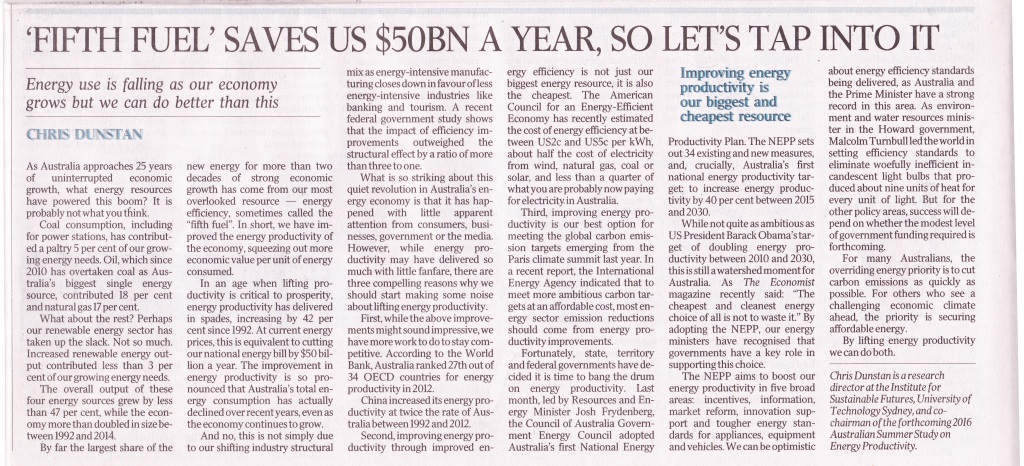As highlighted in The Australian on February 8th, 2016, lifting energy productivity has contributed more to Australia's quarter century of strong economic growth than coal, oil, gas and renewable energy combined. It is also the biggest contributor to cutting carbon emissions. It's about time energy productivity received the attention it deserves!
The 2016 Australian Summer Study on Energy Productivity, (Sydney, 24-26 February 2016) aims to do just that. CEEC directors Joe Pease and Mary Stewart will be joined by Philippa Sjoquist from Rio Tinto in a panel discussion led by this writer at the Summer Study. Come along and contribute to this important discussion. Join me and the stellar line up of international and Australian experts on clean energy and energy productivity at: www.summerstudy.org.au.
‘Fifth fuel’ saves us $50bn a year, so let’s tap into it
CHRIS DUNSTAN
THE AUSTRALIAN, FEBRUARY 8, 2016 12:00AM
Coal is but one of our energy sources, contributing 5 per cent of our growing needs.
As Australia approaches 25 years of uninterrupted economic growth, what energy resources have powered this boom? It is probably not what you think.
Coal consumption, including for power stations, has contributed a paltry 5 per cent of our growing energy needs. Oil, which since 2010 has overtaken coal as Australia’s biggest single energy source, contributed 18 per cent and natural gas 17 per cent.
What about the rest? Perhaps our renewable energy sector has taken up the slack. Not so much. Increased renewable energy output contributed less than 3 per cent of our growing energy needs.
The overall output of these four energy sources grew by less than 47 per cent, while the economy more than doubled in size between 1992 and 2014.
By far the largest share of the new energy for more than two decades of strong economic growth has come from our most overlooked resource — energy -efficiency, sometimes called the “fifth fuel”. In short, we have improved the energy productivity of the economy, squeezing out more economic value per unit of energy consumed.
In an age when lifting productivity is critical to prosperity, energy productivity has delivered in spades, increasing by 42 per cent since 1992. At current energy prices, this is equivalent to cutting our national energy bill by $50 billion a year. The improvement in energy productivity is so pronounced that Australia’s total energy consumption has actually declined over recent years, even as the economy continues to grow.
And no, this is not simply due to our shifting industry structural mix as energy-intensive manufacturing closes down in favour of less energy-intensive industries like banking and tourism. A recent federal government study shows that the impact of efficiency improvements outweighed the structural effect by a ratio of more than three to one.
What is so striking about this quiet revolution in Australia’s energy economy is that it has happened with little apparent attention from consumers, businesses, government or the media. However, while energy productivity may have delivered so much with little fanfare, there are three compelling reasons why we should start making some noise about lifting energy productivity.
First, while the above improvements might sound impressive, we have more work to do to stay competitive. According to the World Bank, Australia ranked 27th out of 34 OECD countries for energy productivity in 2012.
China increased its energy productivity at twice the rate of Australia between 1992 and 2012.
Second, improving energy productivity through improved energy efficiency is not just our biggest energy resource, it is also the cheapest. The American Council for an Energy-Efficient Economy has recently estimated the cost of energy efficiency at between US2c and US5c per kWh, about half the cost of electricity from wind, natural gas, coal or solar, and less than a quarter of what you are probably now paying for electricity in Australia.
Third, improving energy productivity is our best option for meeting the global carbon emission targets emerging from the Paris climate summit last year. In a recent report, the International Energy Agency indicated that to meet more ambitious carbon targets at an affordable cost, most energy sector emission reductions should come from energy productivity improvements.
Fortunately, state, territory and federal governments have decided it is time to bang the drum on energy productivity. Last month, led by Resources and Energy Minister Josh Frydenberg, the Council of Australia Government Energy Council adopted Australia’s first National Energy Productivity Plan. The NEPP sets out 34 existing and new measures, and, crucially, Australia’s first ¬national energy productivity target: to increase energy produc¬tivity by 40 per cent between 2015 and 2030.
While not quite as ambitious as US President Barack Obama’s target of doubling energy productivity between 2010 and 2030, this is still a watershed moment for Australia. As The Economist magazine recently said: “The cheapest and cleanest energy choice of all is not to waste it.” By adopting the NEPP, our energy ministers have recognised that governments have a key role in supporting this choice.
The NEPP aims to boost our energy productivity in five broad areas: incentives, information, market reform, innovation support and tougher energy standards for appliances, equipment and vehicles. We can be optimistic about energy efficiency standards being delivered, as Australia and the Prime Minister have a strong record in this area. As environment and water resources minister in the Howard government, Malcolm Turnbull led the world in setting efficiency standards to eliminate woefully inefficient incandescent light bulbs that produced about nine units of heat for every unit of light. But for the other policy areas, success will depend on whether the modest level of government funding required is forthcoming.
For many Australians, the overriding energy priority is to cut carbon emissions as quickly as possible. For others who see a challenging economic climate ahead, the priority is securing ¬affordable energy.
By lifting energy productivity we can do both.
Chris Dunstan is a research director at the Institute for Sustainable Futures, University of Technology Sydney, and co-Chair of the forthcoming 2016 Australian Summer Study on Energy Productivity.

